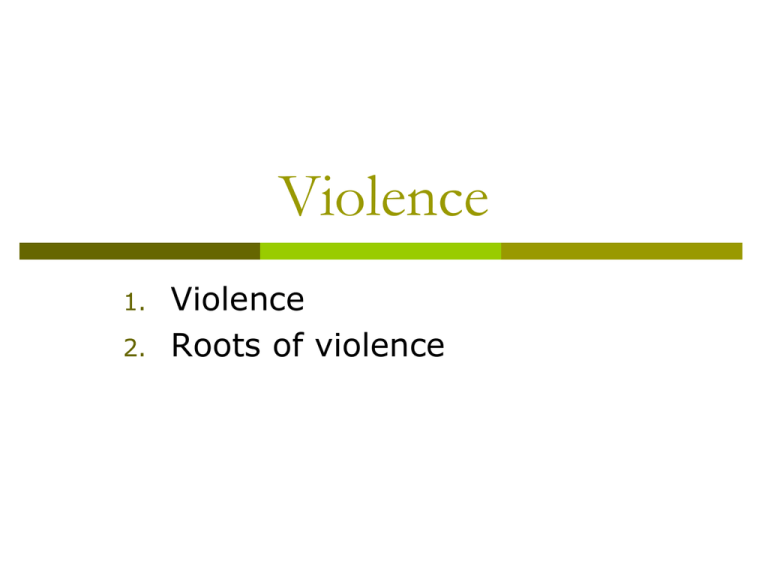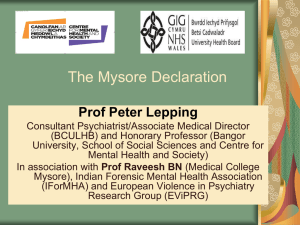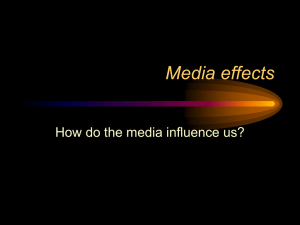Violent Crimes
advertisement

Violence 1. 2. Violence Roots of violence GST Strain ANGER Criminal Behavior Assignment # 4 According to Agnew, males and females tend to experience different types of strain. Males: 1) financial problems; 2) work-related problems, 3) status; 4) conflict and competition with peers; Females: 1) abortion; 2) STD 3) verbal, sexual, and physical victimization; 4) gender-based discrimination; 5) child care problems; 6) stressors involving family and friends; 7) low prestige at work; 8) fitting in (looks+popularity); Assignment # 4 Males and females differ in terms of their emotional reactions to strain. Males: Anger+Moral outrage Females: Anger+Fear +Depression+Anxiety+Guilt+Self-blame Assignment # 4 Males and females differ in terms of their behavioral reactions to strain. Males: Crime and delinquency Females: Self-destructive behaviors such as eating disorders, alcohol/drugs, running away from home, self-injuring, selfcutting, prostitution. Final Exam New Format 50 Multiple Choice Questions Practice questions? Roots of violence What causes people to behave violently? Adults and violence Children and violence Several competing explanations Sources of Violence Ineffective families Personal Traits Substance abuse Violence Firearm availability Cultural Values Ganging Regional Values Human Instincts Personality Traits Abnormal personality structures Depression, impulsivity, aggression, dishonesty, pathological lying, lack of remorse, psychopathology Many murderers kill themselves shortly after committing their crime There cases when people who commit murder wait for the execution (form of “Suicide-murder”) Ineffective families Absent/deviant parents Inconsistent discipline Lack of supervision Abused children Patterson’s Social-Interactional Developmental Model (1989) Children and their environment are in constant interchange The start of antisocial behavior happens in dysfunctional families (harsh and inconsistent discipline, little positive parental involvement, poor monitoring) Family members directly “train” the child to perform antisocial behaviors Patterson’s Social-Interactional Developmental Model (1989) In dysfunctional families, coercion is a way of life Child might see that only coercion can stop other family members from employing hitting Antisocial children manifest “conduct problems” outside the home (rejected by peers) Later they gravitate toward “deviant peer groups” This association reinforces delinquent behavior Later these children will have dysfunctional families and promote coercion Mark Colvin-Differential Coercion Theory Non-coercive and consistent Non-coercive and erratic Coercive and consistent (depression) Coercive and erratic (chronic criminal) Likelihood of crime varies according to the amount of coercion experienced Low coercion produces low anger, high selfesteem, strong social bonds High erratic coercion produces high anger, low self-esteem, weak social bonds Mark Colvin-Differential Coercion Theory Individuals with background of coercion are more likely to get involved in coercive situations and respond to them with violence They create and maintain the cycle of coercion (coercive to future children+partners) They become caught up in a coercive cycle Abused Children Eric and Lyle Menendez were convicted of firstdegree murder for the brutal shotgun slaying of their parents in Beverly Hills. Their defense was based on the “abuse excuse” The apparent motives ranged from the brothers’ fear of their father’s abuse to their desire to collect $11 million in insurance Evolutionary factors Human instincts (survival instinct) Violent behavior is committed predominantly by males Sexually aggressive males have been the ones most likely to produce children Exposure to violence At home, school, neighborhood Mental health Deviant behavior Victimization Vulnerable to the lure of gangs and other deviant groups Cultural/Regional Values Violence-prone subcultures Violence is used to solve social conflicts and dilemmas Ganging Regional values (murder rate is higher in the South) Ganging Rising homicide rates in the 1960s and 1970s have been linked to increased gang activity and drug trafficking in central cities Patterns of violence in large cities strongly influence national trends Homicide rates Cultural Values “Legitimation of violence” hypothesis (Archer, Gartner, 1984) argues that during wartime pro-violent values are reinforced and these values are carried over to postwar periods Increase in homicide rates after World War II, the Korean War, and the Vietnam War are consistent with this idea Firearm availability Greater social acceptance of violence as method of conflict resolution Violence is deeply woven into the fabric of American culture (street talk, prime-time television programming, “gangsta rap” music lyrics)









